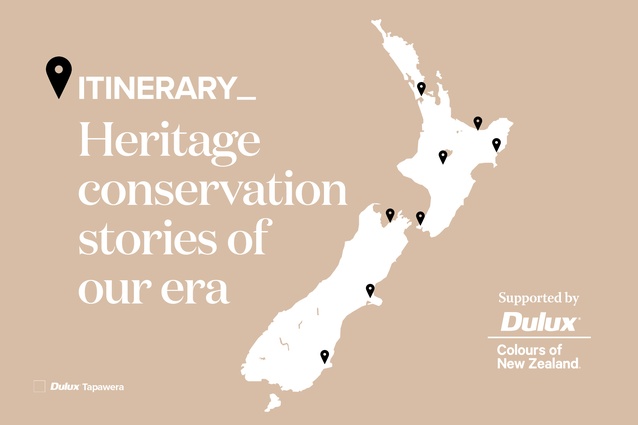Itinerary: Heritage conservation stories of our era
In this month’s itinerary, supported by Dulux Colours of New Zealand, Andrew Barrie and Julia Gatley call attention to 14 heritage sites under conservation in New Zealand.
Sometimes, it seems that demolitions have a more vivid place in people’s memories than do heritage conservation success stories. Everyone remembers Aniwaniwa.
Today, government policy and legislation are providing huge challenges for heritage. The National Policy Statement on Urban Development 2020 encourages urban intensification, with little regard for heritage value, and the Resource Management (Enabling Housing Supply and Other Matters) Amendment Act 2021 supports its implementation.
In addition, seismic strengthening deadlines introduced with amendments to the Building Act in 2016 are almost upon us. The first of these is 1 July 2027, as territorial authorities in high-risk seismic areas were to have identified potentially earthquake-prone buildings in “priority” categories (according to building type, construction technology, use and location) by 1 January 2020, with owners then having 7.5 years to undertake the remediation work. The required work is expensive for most owners, prohibitively so for many, and there is little public funding for it. Without remediation, a building, or a part of a building, effectively becomes ‘red stickered’. Buildings in smaller towns where rental incomes are lower are particularly at risk.
The bigger picture, however, is that climate change is also upon us and, as American architect Carl Elefante wrote in 2007, “The greenest building… is the one that is already built”. Retention of existing buildings makes best use of their embodied energy and is consistent with the reduce/reuse/recycle ethos. Retention of heritage buildings is further important because they are valued by communities and individuals; they contribute to place, memory and people’s sense of identity.
New Zealanders have been working to save important buildings from demolition since the beginning of the 20th century. The architects who worked on early conservation projects did so intuitively rather than with specialist knowledge. The Historic Places Act 1954 established the national heritage agency. Among other things, it built up a property portfolio. The initial work on buildings owned by the New Zealand Historic Places Trust (now Heritage New Zealand Pouhere Taonga) was led by Ministry of Works architect John Stacpoole, joined over time by others, including Chris Cochran from the mid-1970s.
Our architectural conservation sector really matured in the 1980s. The Historic Places Act 1980 formalised the buildings classification system now known as listing. Jeremy Salmond and Chris Cochran established the country’s first private practices specialising in heritage work, in Auckland and Wellington respectively, that decade. Ian Bowman was the first New Zealander to complete a master’s degree in architectural conservation, doing so at the University of York in 1986. Central government sponsored five Māori conservators to complete conservation degrees at the University of Canberra between 1986 and 1991. And ICOMOS Aotearoa New Zealand, the New Zealand arm of the International Council on Monuments and Sites, was formed in 1987.
The 1990s and beyond have seen further legislative change, the publication of key guidance documents, including two editions of the ICOMOS New Zealand Charter for the Conservation of Places of Cultural Heritage Value (1993 and 2010), and the expansion of the sector more generally, including a greater number of practices specialising in heritage work. Several of the country’s large practices now employ at least one conservation architect.
Good heritage outcomes require research to understand the original building and a commitment to undertaking as little change as is possible but as much as is necessary to achieve the desired end result. Incorporating change — a new use, new services, seismic strengthening, retrofitting for improved environmental performance and/or universal access — without compromising heritage value is not easy. The fine-grained decisions are often subjective and debatable rather than prescriptive or predetermined.
This itinerary presents a range of projects that are remarkable in different ways. There are, of course, many more.
THE ITINERARY

1. 1986–1989, Old Synagogue (1884–1885)
19A Princes Street, Auckland
Salmond Architect with Marshall Cook
Jeremy Salmond was the first heritage architect to earn an NZIA Gold Medal, doing so in 2018. His adaptive re-use of Auckland’s old Synagogue to serve as a branch of the National Bank was significant in the development of his career in heritage because it moved him beyond residential work and into conservation in the public and commercial realms. The new use was ideal because it allowed the big space in the middle of the building to remain intact. The project earned an NZIA National Award for conservation in 1990. The building is now occupied by the University of Auckland. See John Walsh (ed.), Jeremy Salmond (2018).

2. 1993, Tongariro National Park
Central North Island
Tribal land of Ngāti Tūwharetoa
Tongariro National Park, with its spectacular maunga and volcanic plateau, holds a ‘world first’ within heritage conservation practice; in 1993, it was the first place to be inscribed on UNESCO’s World Heritage (WH) List as an associative cultural landscape. It had been inscribed three years earlier for its natural values but protagonists lobbied for greater attention to be given to Indigenous understandings of place. In this case, tangata whenua see the maunga and other geographic features as spiritual/cultural beings. The WH listing criteria were rewritten and, thus, the national park could be inscribed for its cultural values as well.

3. 1992–1995, Parliament House (1911–1922) and Parliamentary Library (1897–1899)
1 Molesworth Street, Wellington
Warren and Mahoney with Howard Tanner
Seismicity is a major issue for our country, and the base isolation of buildings to help them withstand earthquakes is understood to have been invented here — by engineer Dr Bill Robinson in Wellington in the 1970s. The retrofit base isolation of Parliament House and the Parliamentary Library in the 1990s was notable because Parliament House, in particular, has a large footprint and positioning the rubber, steel and lead isolators under the existing building was a major feat. Apparently, there are 417 of them and they were designed to move up to 300mm in any direction during an earthquake. Holmes Consulting Group did the engineering.
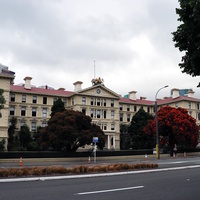
4. 1994–1996, Old Government Buildings (1875–1876)
55 Lambton Quay, Wellington
Department of Conservation and Ian Bowman
This project exemplifies the dilemmas faced in conservation practice. Should replica chimney pots have been introduced, given that the originals were removed years earlier and the new ones were not functional? Should steel have been used to strengthen timber staircases in a building whose main claim to fame is that it is one of the largest timber buildings in the world? These are questions David Kernohan asked of students when teaching heritage conservation at the Wellington School of Architecture in the 1990s. There were no right answers, just evolving points of view and the potential for students to make a good argument.
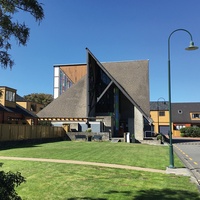
5. 2003–ongoing, Futuna Chapel (1958–1961)
67 Futuna Close, Karori, Wellington
Various, including Chris Cochran, Nick Bevin, Peter Parkes and Lianne Cox
How far would you go to save your favourite building from demolition? A group in Wellington went admirably far to save John Scott’s most celebrated work; they bought it. Futuna Chapel came close to demolition from 2000 when the retreat centre of which it was part was sold to developers wanting to replace the buildings with housing. Locals campaigned for the retention of the chapel and, ultimately, formed the Friends of Futuna Charitable Trust to buy it in 2003. Since then, they have undertaken conservation work incrementally. See Nick Bevin and Gregory O’Brien, Futuna: Life of a Building (2016).
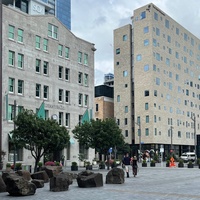
6. 2004–ongoing, Britomart Precinct (1885–ongoing)
Customs, Quay and Queen Streets, and Britomart Place, Auckland. Various, including Salmond Reed Architects and Cheshire Architects
Comprising nine city blocks and developed by Cooper and Company, Britomart is New Zealand’s largest urban regeneration project with a heritage focus. It could easily have been very different. Proposals from the 1980s and ’90s showed much demolition and new high-rises. Then the Auckland City Council had a change of heart and commissioned Salmond Reed to prepare conservation plans for 18 heritage buildings. New buildings have been developed around the carefully revitalised old. It is a project to be celebrated. See Joy Park’s PhD (University of Auckland, 2022) and the Britomart website (britomart.org).

7. 2003–2009, The Pah (1877–1879)
72 Hillsborough Road, Auckland
Matthews & Matthews Architects
The Pah is a large 19th-century house that had had institutional use before it was purchased by the Auckland City Council in 2002 for re-use as an art gallery. In the new Stubbs volume (see ‘Sources’), Robin Byron praises the skill with which Matthews & Matthews fitted multiple new services into the old building, including strengthening, air conditioning, security and a fire protection system, largely tucked in behind old oak dados, parquet flooring and plastered ceilings. Retractable walls increased flexibility and the garden was returned to an earlier design. The project earned an NZIA Local Award in 2010.
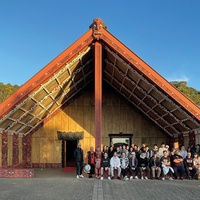
8. 2011, Mataatua Wharenui (1872–1875)
105 Muriwai Drive, Whakatāne
Te Hau o Rangi Tutua (master carver)
The large Ngāti Awa wharenui Mataatua is widely travelled. It was taken by central government in 1879 and shown at international exhibitions in Sydney, Melbourne and London before returning in 1925 — not to Whakatāne but to Dunedin for the New Zealand and South Seas Exhibition — and was then lodged in the Otago Museum. Ngāti Awa had pressed for its return for years. This was finally confirmed through the Waitangi settlement process in 1996, and realised in 2011. The return home is inspiring. See Hirini Mead et al., Mataatua Wharenui (2017). In 2023, Mataatua was listed as a wahi tupuna/tipuna.
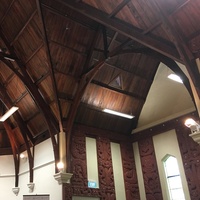
9. 2000–2015, Toko Toru Tapu Church (1913)
73 Whakato Road, Manutuke
Architects 44
The conservation of this significant Māori church has been described as “a labour of love” for Architects 44’s James Blackburne, who led the project across a 16-year period. A Gothic Revival exterior opens to a Māori interior, with whakairo (carved panels) on the walls. Discreet strengthening, devised by Spencer Holmes, was achieved with fibreglass bars, made locally in Gisborne, inserted behind the restored whakairo. The project included repainting, based on paint scrapes to determine original colours, re-roofing using diamond-shaped pressed metal tiles, and the reinstatement of the bell tower. It earned an NZIA National Award in 2016.
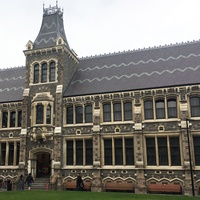
10. 2015–present, The Arts Centre (1877–1923)
2 Worcester Boulevard, Christchurch
Warren and Mahoney and DPA Architects
The Arts Centre, formed in the 1950s, has long occupied the buildings built for Canterbury University College and neighbouring secondary schools. Most of them suffered extensive damage in the Canterbury earthquakes of 2010–2011. In a city once known for its Gothic Revival masonry heritage, each survivor is now valued even more than it was previously. By 2022, two-thirds of The Arts Centre complex had been strengthened, repaired and reopened. Individual projects have earned multiple awards, among them the Great Hall and Clock Tower, which earned a Merit in the UNESCO Asia-Pacific Awards for Cultural Heritage Conservation in 2017.

11. 2014–2018, Nelson School of Music (1895–1901)
48 Nile Street, Nelson
Irving Smith Architects and Ian Bowman
Inside this brick building is a beautiful auditorium with a barrel-vaulted ceiling and internationally renowned acoustics. Also earning international acclaim was the strengthening, repair and restoration project, with a Distinction at the UNESCO Asia-Pacific Awards for Cultural Heritage Conservation and selection as a finalist in the World Architecture Festival (small architecture category), along with an NZIA Local Award, all in 2019. Signalling change is the new entry and foyer between the old buildings, recessed and clearly contemporary with a white awning and glass frontage. See Aaron Betsky (ed.), Unfinished & Far Far Away (2023).
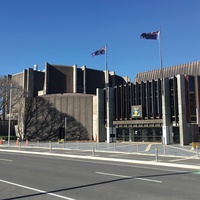
12. 2015–2019, Christchurch Town Hall (1966–1972)
86 Kilmore Street, Christchurch
Warren and Mahoney
That modern buildings can have heritage value is increasingly accepted but it still took a vocal campaign, led by lobby group Keep Our Town Hall, to convince the Christchurch City Council that the city’s Town Hall warranted repair and refurbishment after the Canterbury earthquakes. Eventually, Council approved it, with site remediation, relevelling, and new foundations and floors all needed. See Ian Lochhead (ed.), The Christchurch Town Hall 1965–2019 (2019). Young Architects’ repair and refurbishment of Miles Warren’s Dorset Street Flats (1956–1957) are also wonderful. Both projects earned NZIA National Awards, in 2021 and 2023 respectively.

13. 2016–2020, Whare Koa Māngere Community Centre (1920s)
141 Robertson Road, Māngere, Auckland
Burgess Treep & Knight Architects
Conservation projects come in all shapes, sizes and budgets. Whare Koa is an Auckland Council community house for Māori and Pacific groups. It looks like a bungalow and the name translates as ‘Happy House’. The exterior colour was restored first, sponsored by PPG Industries New Zealand in 2016, followed by interior refurbishment, where colour is to the fore — including pink, orange and yellow — ensuring much bang for buck. The project shows that architects can have fun with heritage, particularly when the design strategies support community aspirations. This one earned NZIA Local Awards for Heritage and Colour in 2021.
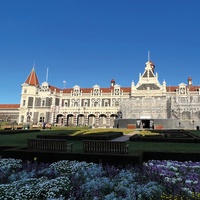
14. 2021–2023, Dunedin Railway Station (1905–1906)
Anzac Avenue, Dunedin
Salmond Reed Architects
The George Alexander Troup-designed Railway Station, completed in 1906, is one of Dunedin’s most significant and admired buildings. The conservation project was led by Salmond Reed’s Phillip Hartley, working with a team of specialists including stonemasons and metal fabricators. It was primarily a repair project, meaning as much of the old fabric as possible was kept and repaired, and only that which was beyond repair was replaced. This approach was applied for the stone walls, Marseille tiled roof and copper-clad cupolas: conservation at its best. A YouTube video with those involved discussing the project is worth searching out.
OTHER ADDRESSES
As expected, the properties owned and/ or managed by Heritage New Zealand Pouhere Taonga exemplify bestpractice conservation work. Favourites include:
Pompallier
5 The Strand, Russell
Kerikeri Mission House
218 Kerikeri Road, Kerikeri
Stone Store
248 Kerikeri Road, Kerikeri (best shop)
Māngungu Mission House
107 Motukiore Road, Māngungu
Alberton
100 Mount Albert Road, Mount Albert, Auckland
Highwic
40 Gillies Avenue, Epsom, Auckland
Antrim House
63 Boulcott Street, Wellington
Old St Paul’s
34 Mulgrave Street, Thorndon, Wellington
Fyffe House
Avoca Point, Kaikōura
Timeball Station
2 Reserve Terrace, Lyttelton
Totara Estate
Alma-Maheno Road (SH1), Totara, near Oamaru (best Devonshire tea)
For more on great house museums, see Sebastian Clarke’s Itinerary in Architecture NZ, Jan/Feb 2022, pp. 87–89.
SOURCES
This itinerary was informed by research conducted for the recently published book, Architectural Conservation in Australia, New Zealand and the Pacific Islands: National Experiences and Practice, written with John H. Stubbs, William Chapman, Ross King and another 60 contributors, and published by Routledge. For information, see Routledge’s website.
It is the fourth in an international series of books led by Stubbs, comes almost 25 years after Alexander Trapeznik’s still very useful Common Ground?: Heritage and Public Places in New Zealand (Dunedin: University of Otago Press, 2000) and includes a bibliography of sources on historic preservation in New Zealand (pp. 325–327). Notable in the bibliography is the growing number of PhD theses on heritage conservation topics.
For information on the individual places in the itinerary, the Heritage New Zealand Pouhere Taonga website is an excellent starting point, and the NZIA’s growing online database of local and national awards is also increasingly valuable.

The Itinerary series is supported by Dulux Colours of New Zealand. Dulux Colour Specialist Davina Harper has selected a Colours of New Zealand palette based on this itinerary. See the full range and order colour samples here.


